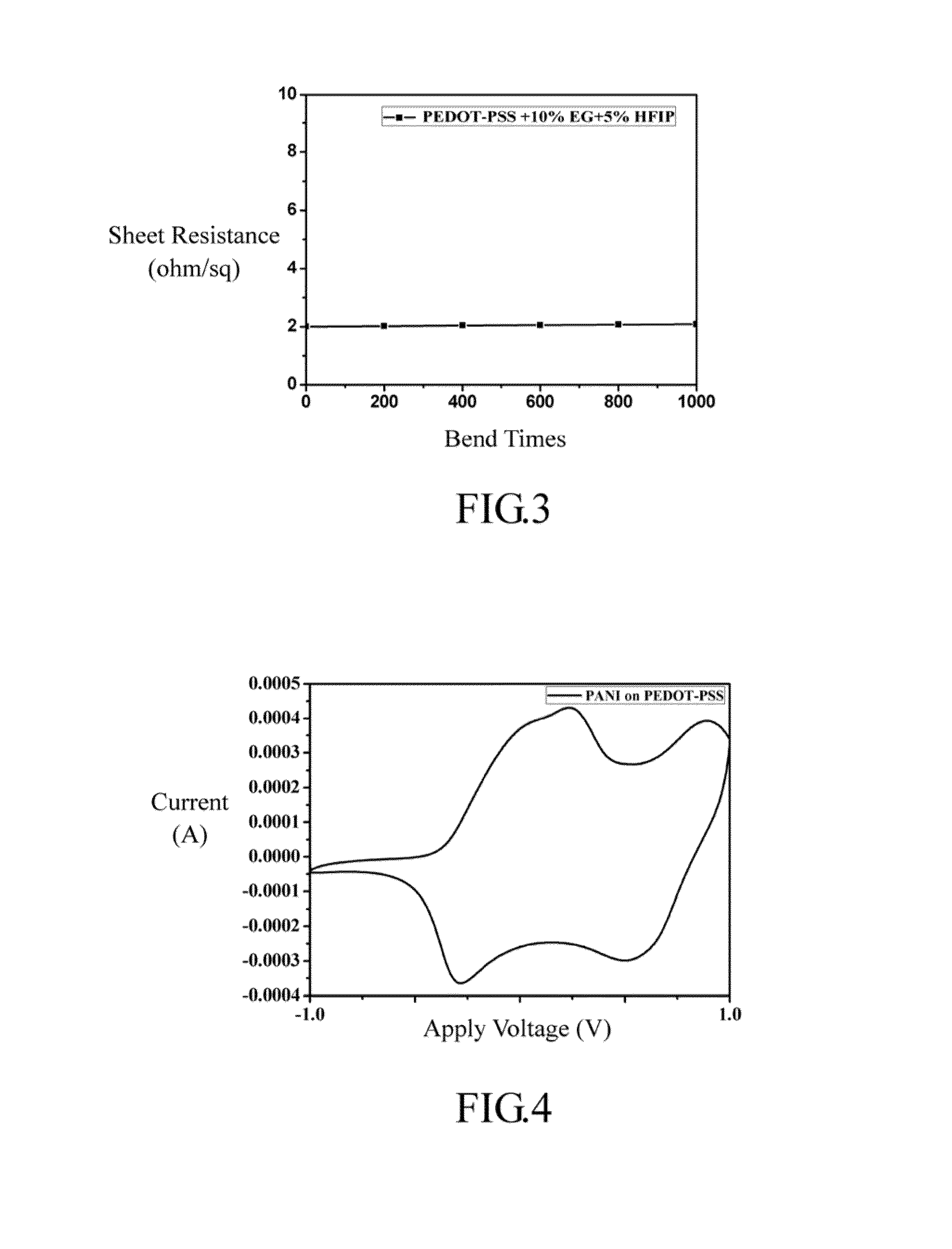Methods for fabricating and treating doped conjugated polymer film
- Summary
- Abstract
- Description
- Claims
- Application Information
AI Technical Summary
Benefits of technology
Problems solved by technology
Method used
Image
Examples
example 1
Fabrication of PEDOT:PSS Film and its Conductivity, Thermal Stability and Bending Test
[0047]Fabrication of PEDOT:PSS film
[0048]PEDOT:PSS (poly(styrenesulfonate, formula (12)) (0.1 g) was dissolved in water (10 mL) to form a PEDOT:PSS aqueous solution (1 wt %). Herein, PSS is used as the dopant in the PEDOT, and the weight ratio of PEDOT:PSS is 1:2.5. Different amounts of HFIP (5 wt %, 10 wt %, 15 wt %, and 20 wt % with respect to the PEDOT:PSS aqueous solution) were added to PEDOT:PSS aqueous solution, followed by sonication for 1 hr. 100 μl samples of the pure PEDOT:PSS aqueous solution and PEDOT:PSS aqueous solutions with 4 different concentrations of HFIP were transferred to five glass plates (1×1 cm2), heated to 100° C. and dried. The sheet resistances of these five samples are listed in table 1 (No. 1-5). The results show that the PEDOT:PSS film fabricated from the mixture of PEDOT:PSS, HFIP (polar substance) and water (polar solvent) has lower sheet resistance than the PEDOT:P...
example 2
Treating PANI:PSS Film by Mixed Solution
[0055]Fabrication of PANI:PSS film
[0056](NH4)2S2O8 (0.41 g) was dissolved in 1.2M HCl(aq) solution (10 mL), aniline monomer (0.17 g) and phenol (1.7×g) were dissolved in 1.2M HCl(aq) solution (26 mL). The HCl(aq) (NH4)2S2O8 containing solution and aniline monomer containing solution were mixed to perform the polymerization in room temperature. After reaction for 20 minutes, dark-green doped PANI (solid) forms in the reaction solution. The reaction solution was then filtered to obtain the solid part, which was washed by distilled water, methanol and HCl(aq) solution until the filtrate became colorless. However, the as-prepared PANI doped with HCl has low conductivity. Thus, 0.1M ammonia water was added to dedope the PANI powder, and dried in vacuum. The dried powder (0.1 g) was dissolved in 0.1M PSS (20 mL, M.W.=75000) aqueous solution to obtain the desired doped PANI:PSS solution (see formula (13), wherein PANI:PSS=3:2).
[0057]Fabrication and t...
example 3
PEDOT:PSS Film Applied to Dye-Sensitized Solar Cell (DSSC)
[0059]In this embodiment, the titanium dioxide (TiO2) slurry was formed on a cleaned conductive glass (FTO) by screen printing, and heats in a tube furnace at 450° C. Thus, Tit), forms anatase crystalline phase and tightly attached on the surface of the FTO (fluorine-doped tin oxide) glass. Two layers of TiO2 films with small TiO2-particle and one layer of large-particle TiO2 diffusing layer were deposited thereon in sequence to fabricate a TiO2 electrode. The fabricated TiO2 electrode was dipped in 3×10−4 M N719 (cis-bis(isothiocyanato)bis-(2,2′-bipyridyl-4,4′-dicar-boxylato)-ruthenium(II)bis-tetrabutyl-ammonium) ethanol solution for 4 hrs, washed by alcohol and dried in a Petri dish. Two types of PEDOT:PSS solutions (No. 1 of table 1 and No. 18 of table 1) were dropped on two glass plates respectively, followed by heating and drying to form PEDOT:PSS counter electrode. The dye adsorbed TiO2 electrode and the PEDOT:PSS count...
PUM
| Property | Measurement | Unit |
|---|---|---|
| Percent by mass | aaaaa | aaaaa |
| Percent by mass | aaaaa | aaaaa |
| Percent by mass | aaaaa | aaaaa |
Abstract
Description
Claims
Application Information
 Login to View More
Login to View More - R&D
- Intellectual Property
- Life Sciences
- Materials
- Tech Scout
- Unparalleled Data Quality
- Higher Quality Content
- 60% Fewer Hallucinations
Browse by: Latest US Patents, China's latest patents, Technical Efficacy Thesaurus, Application Domain, Technology Topic, Popular Technical Reports.
© 2025 PatSnap. All rights reserved.Legal|Privacy policy|Modern Slavery Act Transparency Statement|Sitemap|About US| Contact US: help@patsnap.com



